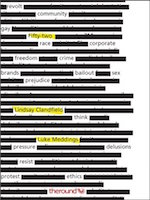52: A Year of Subversive Activities for the ELT Classroom

52 by Lindsay Clandfield and Luke Meddings is an e-book collection of subversive activities for the ELT classroom. Each of the activities in the book attempts to engage the learner and the teacher in a challenging conversation. They are both forced to question, investigate, and debate the world that we live in.
The book is organised into 52 different activities which can be used in any order. It isn’t a coursebook designed to be worked through, but rather a resource book where the teacher can dip in and out and pick the activities that appeal to them and skip the ones that don’t. Furthermore, the writers actively encourage the user to customise, develop, and repurpose their own particular situation.
Perhaps most unusually for an ELT resource book, there are no clear language exponents or proficiency levels indicated in the book. The concept underpinning this decision is that interesting, thought-provoking materials will create a response from the students that will lead to fertile language development.
In comparison with the content of nearly all currently published ELT materials, what 52 offers might seem counter to what most teachers look for in published material. It appears they want clear and precise directions about who, where, when, how, and why they should use the activities, and this is understandable for many reasons we are all familiar with.
52 does things in a different way. Let’s look at activity 1 as an example. The teacher is invited to place subversive slogans in strategic positions around the school, such as “Children know everything”, “Can you escape?” and “Replace the empty mind with an open mind”. It is then suggested that the students join the conversations that spring from these slogans as and when they wish. The final instruction is simply the question, “Do teachers and learners react in the same way?”
What is striking about this activity is what is absent. As I mentioned previously, there is no language objective, no indication of the kind of grammar that could be practiced, and, furthermore, no general aims, no specific mention of materials, no suggested follow-up, no idea of the time required, and only the most minimal of instructions given to the teacher.
The contrast with mainstream ELT publishing is particularly striking as the book is self-published by the authors as part of The Round, the “independent collective of authors and creatives in English language teaching”. It is very difficult to imagine this kind of material coming from any of the major ELT publishers, so in both content and distribution, 52 provides an alternative to the mainstream in ELT, and as with others areas, it is in the outer limits where the most interesting things are happening.
The fact is that this book is challenging for most teachers. It provides no support, no security. It demands a lot from both the teacher and the student. As the authors say in the introduction, “This book is not for everyone”. Indeed, there are activities in there that I wouldn’t use, and that is surely the point.
In my view, one of the main criticisms regularly and justifiably leveled at coursebooks is their uniformity and subsequent blandness. Activities such as those included in 52 are the polar opposite of this, and as such will be very appealing to those teachers who are looking to push themselves and their students to reach a higher level of discussion and debate.
James Taylor
